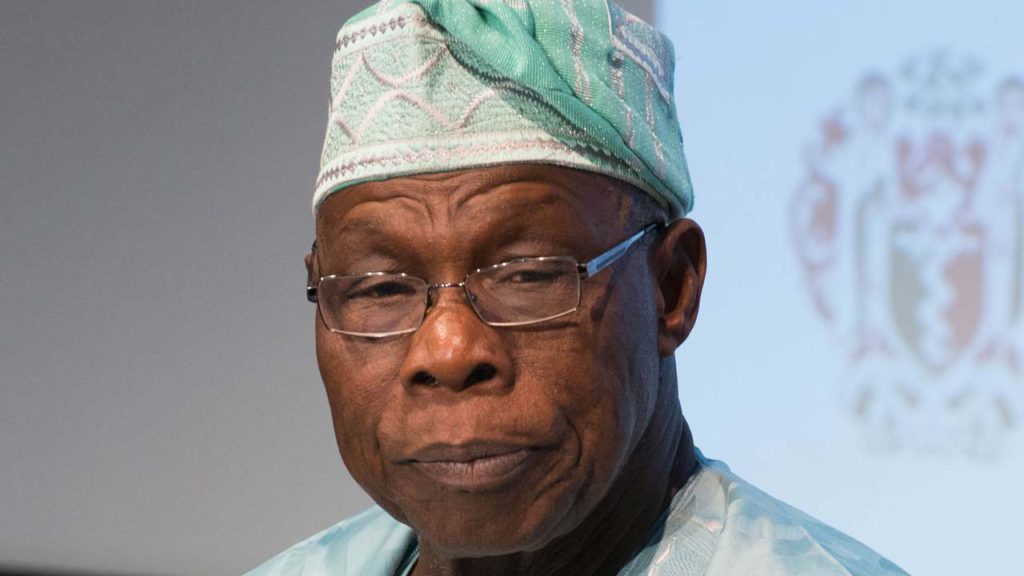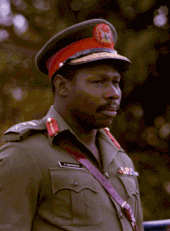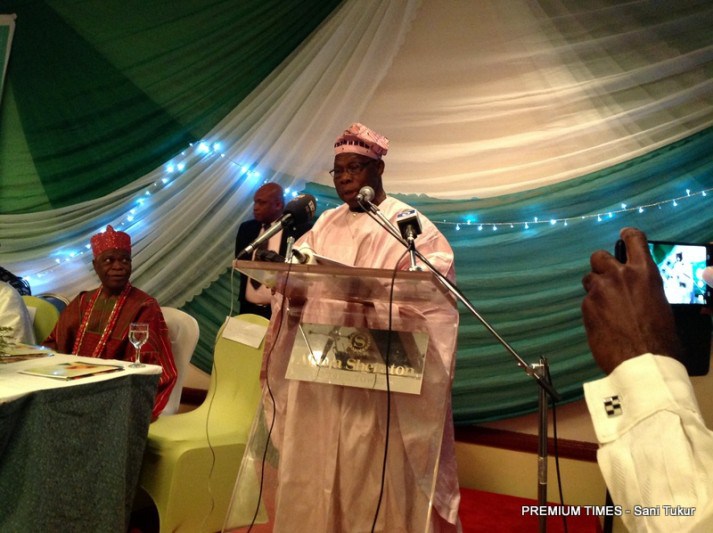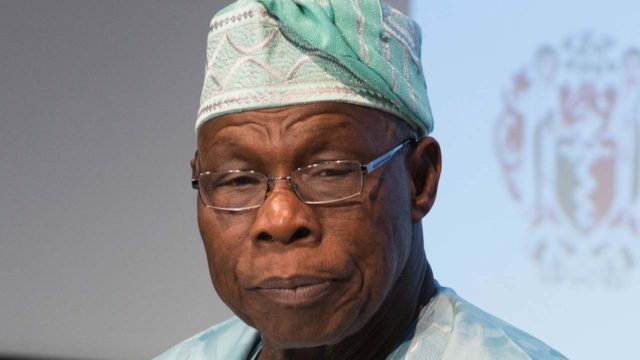 Olusegun Mathew Okikiola Aremu Obasanjo, GCFR Yoruba: Olúṣẹ́gun Ọbásanjọ́ born c. 5 May 1937) is a former Nigerian Army general who was President of Nigeria from 1999 to 2007. Obasanjo was a career soldier before serving twice as his nation’s head of state. He served as a military ruler from 13 February 1976 to 1 October 1979, and as a democratically elected president from 29 May 1999 to 29 May 2007. From July 2004 to January 2006, Obasanjo also served as Chairperson of the African Union.
Olusegun Mathew Okikiola Aremu Obasanjo, GCFR Yoruba: Olúṣẹ́gun Ọbásanjọ́ born c. 5 May 1937) is a former Nigerian Army general who was President of Nigeria from 1999 to 2007. Obasanjo was a career soldier before serving twice as his nation’s head of state. He served as a military ruler from 13 February 1976 to 1 October 1979, and as a democratically elected president from 29 May 1999 to 29 May 2007. From July 2004 to January 2006, Obasanjo also served as Chairperson of the African Union.
Olusegun Obasanjo was born on 5 May 1937 to his father Amos Adigun Obasanjo Bankole and his mother Ashabi in Abeokuta, Ogun State, Nigeria. His mother died in 1958 and his father died in 1959. He became an orphan at the age of 22.
In 1948, Obasanjo enrolled into Saint David Ebenezer School at Ibogun, for his primary school education. From 1952 to 1957, he attended Baptist Boys High School (BBHS), Abeokuta, for his secondary school education.
Military career
In 1958, Olusegun Obasanjo joined the Nigerian army. Some of his studies and training includes: Mons Cadet School, Aldershot, England; Royal College of Military Engineers, Chatham, England; School of Survey, Newbury, England; Indian Army School of Engineering, Poona; Royal College of Defence Studies, London.
Obasanjo served in the 5th Battalion of the Nigerian Army in Kaduna and in Cameroon between 1958 and 1959. He was commissioned Second Lieutenant in the Nigerian Army 1959 and promoted a Lieutenant in 1960.
At the rank of Lieutenant, Obasanjo served in the Nigerian contingent of the United Nations Force in the Congo (now Zaire) in 1960. He later joined the then only Engineering Unit of the Nigerian Army and became its unit commander in 1963.
In 1963, Obasanjo was promoted to the rank of captain, in Nigerian Army. He was attached to Indian Army Engineering School, at Kirkee, India in 1965. That year he was promoted to the rank of Major.
In 1965, he attended the Defence Services Staff College Wellington, India (In a book, the 40th anniversary book on the Defence Services Staff College, Wellington, India, 1947-1987, Col. R.D. Palsokar (retired) quoted the commandant’s confidential report on the then Major Obasanjo of the 20th staff course set in 1965, as saying that he was “the best officer who was sent up till then from that country (Nigeria) to Wellington. Palsokar also stated: “He was particularly popular in all circles).
Obasanjo was promoted lieutenant colonel in 1967, appointed commander Second Area command of the Nigerian Army. He was made Commander, Garrison, Ibadan, Nigeria, between 1967 and 1969.
Obasanjo’s colonel promotion came in 1969. He was appointed from 1969-1970, general officer commanding 3rd Infantry Division, Nigerian Army. He was later made the commander, Third Marine Commando Division, South-Eastern State, during the Nigerian Biafran Civil War.
On 12 January 1970, Obasanjo accepted the Biafran surrender ending the Nigerian Civil War.
From 1970 to 1975, he was the Commander of the Engineering Corps, Nigerian Army. Earlier in 1972, he was promoted to the rank of Brigadier general.
In January 1975 the head of state for the federal republic of Nigeria, General Yakubu Gowon, made Obasanjo the Federal commissioner for works and housing.
On 29 July 1975, when General Murtala Mohammed took power as head of state via a military coup, Obasanjo was appointed as the chief of staff supreme headquarters. In January 1976 he was promoted to lieutenant general.
Following a failed coup by lieutenant colonel Dimka in which General Murtala Mohammed was killed, Obasanjo was chosen as Head of state by the supreme military council on 13 February 1976.
Obasanjo resigned as head of state and also resigned from the army on 1 October 1979, handing over power to the newly elected civilian president of Shehu Shagari.
Federal Commissioner for Works and Housing
In January 1975, General Yakubu Gowon, appointed Obasanjo as the Federal commissioner for works and housing to oversee the development of housing, highways, roads, bridges, electrical and street lighting in the country following the oil boom.
Chief of Staff, Supreme Headquarters
In July 1975, General Murtala Mohammed took power as head of state via a military coup, Obasanjo was appointed as the chief of staff supreme headquarters.
Military coup of 13 February 1976
On 13 February 1976, coup plotters, led by Army Col. Dimka, marked him, Murtala and other senior military personnel for assassination. Murtala was killed during the attempted coup, but Obasanjo escaped death. The low profile security policy adopted by Murtala had allowed the plotters easy access to their targets. The coup was foiled because the plotters missed Obasanjo and General Theophilus Danjuma, chief of army staff and de facto number three man in the country. The plotters failed to monopolize communications, although they were able to take over the radio station to announce the coup attempt.
Obasanjo and Danjuma established a chain of command and re-established security in Lagos, thereby regaining control. Obasanjo was appointed as head of state by the Supreme Military Council. Keeping the chain of command established by Murtala, Obasanjo pledged to continue the programme for the restoration of civilian government in 1979 and to carry forward the reform programme to improve the quality of public service.
Head of State (1976-79)
 Oil boom
Oil boomThe military regime of Obasanjo benefited from oil revenues that increased. Increased oil revenues permitted government spending for infrastructure and improvements on a large scale; critics thought it was poorly planned and concentrated too much in urban areas. The oil boom was marred by a minor recession in 1978-79.
The government planned to relocate the federal capital from Lagos to Abuja, a more central location in the interior of the country. It intended to encourage industrial development inland and relieve the congestion in the Lagos area. Abuja was chosen because it was not identified with any particular ethnic group.
However, as head of state, Obasanjo reduced the share of oil royalties and rents to state of origin from 50 to 30 percent.
Industry

Industrialisation, which had grown slowly after World War II through the civil war, boomed in the 1970s, despite many infrastructure constraints. Growth was particularly pronounced in the production and assembly of consumer goods, including vehicle assembly, and the manufacture of soap and detergents, soft drinks, pharmaceuticals, beer, paint, and building materials. The Obasanjo government invested strongly in infrastructure, and the number of “parastatals” — jointly government- and privately owned companies — proliferated. The Nigerian Enterprises Promotion decrees of 1977 further encouraged the growth of an indigenous middle class.
Heavy investment was planned in steel production. With Soviet assistance, a steel mi
ll was developed at Ajaokuta in Kogi State, not far from Abuja. Agriculture and associated projects generally declined, although the government undertook large-scale irrigation projects in the states of Borno, Kano, Sokoto, and Bauchi with World Bank support.
The oil boom revenues led to a rise in per capita income, especially for the newly emerging urban middle class. Inflation, particularly in the price of food, promoted both industrialisation and the expansion of agricultural production. With the government encouraging food crops, the traditional export earners — peanuts, cotton, cocoa, and palm products — declined in significance and then ceased to be important at all. Nigeria’s exports became dominated by oil.
Education
Education also expanded under Obasanjo. At the start of the civil war, there were only five universities, but by 1975 the number had increased to thirteen, with seven more to be established over the next several years. In 1975 there were 53,000 university students. Similar advances were made in the expansion in primary and secondary school education, particularly in those northern states that had lagged behind others. During Obasanjo’s regime, universal primary school education was introduced nationwide.
 Political repression
Political repression
Obasanjo was also accused of being responsible for political repression. In one particular instance, the compound of Nigerian musician and political activist Fela Kuti was raided and burned to the ground after a member of his commune was involved in an altercation with military personnel. Fela and his family were beaten and raped and his mother, political activist Funmilayo Ransome Kuti, was killed by being thrown from a window. Her coffin was carried to Obasanjo’s barracks as a protest against political repression.
Transition to democracy
The second republican constitution, which was adopted in 1979, was modelled on the Constitution of the United States, with provision for a President, Senate, and House of Representatives. The country was prepared for local elections to be followed by national elections, in the hopes of returning Nigeria to civilian rule.
On 1 October 1979, Obasanjo handed power to Shehu Shagari, a democratically elected civilian president, hence becoming the first military head of state to transfer power peacefully to a civilian regime in Nigeria.
Imprisonment
During the dictatorship of Sani Abacha (1993–1998), Obasanjo spoke out against the human rights abuses of the regime, and was imprisoned for alleged participation in an aborted coup based on testimony obtained via torture. He was released only after Abacha’s sudden death on 8 June 1998. While in prison, Obasanjo became a born-again Christian.
Recollecting his experience during the trial of the coup, Obasanjo says “My saddest day was when I sat in front of a military panel set up by late former Head of State, Sani Abacha to try me over a phantom coup, and sentenced to death and later commuted to 30 years imprisonment.”
Presidential campaigns and elections
1999 presidential elections
In the 1999 presidential elections, Obasanjo ran on the platform of the Peoples Democratic Party, PDP, and defeated Olu Falae, the joint candidate of the All Peoples Party, APP, and the Alliance for Democracy, AD.
2003 presidential elections
In 2003, President Olusẹgun Ọbasanjọ ran for a second term under People’s Democratic Party and won by a margin of more than 11 million votes.
Presidency (1999-2007)
First term

Obasanjo spent most of his first term travelling abroad. He succeeded in winning at least some Western support for strengthening Nigeria’s nascent democracy. Britain and the United States, in particular, were glad to have an African ally who was openly critical of abuses committed in Robert Mugabe’s Zimbabwe at a time when many other African nations (including South Africa) were taking a softer stance. Obasanjo also won international praise for Nigeria’s role in crucial regional peacekeeping missions in Sierra Leone and Liberia. The international community was guided in its approach to Obasanjo in part by Nigeria’s status as one of the world’s 10 biggest oil exporters as well as by fears that, as the continent’s most populous nation, Nigerian internal divisions risked negatively affecting the entire continent.
Some public officials like the National Assembly speaker and Senate president were involved in conflicts with the president, who had to battle many impeachment moves from both houses.Obasanjo managed to survive impeachment and was renominated.
Second term

In November 2003, Obasanjo was criticized for his decision to grant asylum to the deposed Liberian president, Charles Taylor.
On June 12, 2006 he signed the Greentree Agreement with Cameroonian President Paul Biya which formally put an end to the Bakassi peninsula border dispute. Even though the Nigerian Senate passed a resolution declaring that the withdrawal of Nigerian troops from the Bakassi Peninsula was illegal, Obasanjo gave the order for it to continue as planned.
Oil revenue
With the oil revenue, Obasanjo created the Niger Delta Development Commission and implemented the Universal Basic Education Program to enhance the literacy level of Nigerians. He constituted both the Independent Corrupt Practices Commission and the Economic and Financial Crimes Commission. Resuscitated the National Fertilizer Company in Kaduna and (Onne) Port Harcourt. Obasanjo increased the share of oil royalties and rents to state of origin from 3 to 13 percent.
Economic growth and debt payment
Before Obasanjo’s administration, Nigeria’s GDP growth had been painfully slow since 1987, and only managed 3 per cent between 1999/2000. However, under Obasanjo the growth rate doubled to 6 per cent until he left office, helped in part by higher oil prices. Nigeria’s foreign reserves rose from $2 billion in 1999 to $43 billion on leaving office in 2007. He was able to secure debt pardons from the Paris and London club amounting to some $18 billion and paid another $18 billion to be debt free. Most of these loans were accumulated from short term trade arrears during the exchange control period. (Point of correction). Most of these loans were accumulated not out of corruption but during a period 1982-1985 when Nigeria operated exchange control regime that vested all foreign exchange transactions on the central bank of Nigeria. The naira exchange rate to the US dollar and other major currencies during this period was highly regulated and artificially high. Nigerian importers paid local currency equivalent to the central bank through their local commercial banks but during the oil glut period of 1982-86 when foreign exchange was scarce the central bank did not have enough foreign exchange to pay for current imports. This resulted in short term foreign trade payment arrears. Short term trade arrears averaged about US$3.0 billion each year between 1983 and 1986 when the new military government of General Babangida floated the naira and imports were thereafter paid for on a current basis.
Nigeria stopped accumulating short term foreign trade payment arrears beginning from 1986. Before then, yearly accumulation of around US$3.0 billion created the foreign debt for Nigeria. Subsequent growth of Nigeria’s debt was due to interest on the previous year’s stock of short term trade debt owed to export credit agencies and non-insured creditors (Source:CBN Annual Reports 1983-1986. This information to refute the claim that corruption was the source of Nigeria’s past foreign debt is supplied by Osarenren F. Asemota Former CBN Balance of Payment Staff).
Third term agenda
Obasanjo was embroiled in controversy regarding his “Third Term Agenda,” a plan to modify the constitution so he could serve a third, four-year term as President. This led to a political media uproar in Nigeria and the bill was not ratified by the National Assembly. Consequently, Obasanjo stepped down after the April 2007 general election. In an exclusive interview granted to Channels Television, Obasanjo denied involvement in what has been defined as “Third Term Agenda.” He said that it was the National Assembly (Nigeria) that included tenure elongation amongst the other clauses of the Constitution of Nigeria that were to be amended. “I never toyed with the idea of a third term,” Obasanjo said.
Obasanjo was condemned by major political players during the Third Term Agenda saga. Senator Ken Nnamani, former President of the Nigerian Senate claimed Obasanjo informed him about the agenda shortly after he became President of the Nigerian Senate. “Immediately, I became Senate President, he told me of his intentions and told me how he wanted to achieve it. I initially did not take him seriously until the events began to unfold”. He also insinuated that Eight Billion Naira was spent to corrupt legislators to support the agenda. “How can someone talk like this that he didn’t know about it, yet money, both in local and foreign currencies, exchanged hands,” he asked. Femi Gbajabiamila corroborated Nnamani’s account but put the figure differently, “The money totalled over N 10 billion. How could N10bn be taken out of the national treasury for a project when you were the sitting President, yet that project was not your idea? Where did the money come from?” In the following quotes, Nnamani said President George W. Bush warned Obasanjo to desist from his plan to contest presidential election for the third term: “If you want to be convinced that the man is only telling a lie, pick up a copy of the book written by Condoleza Rice, the former Secretary to the Government of the United States of America. It is actually an autobiography by Rice. On page 628 or page 638, she discussed Obasanjo’s meeting with Bush, how he told the former American President that he wanted to see how he could amend the Constitution, so that he could go for a third term. To his surprise, Bush told him not to try it. Bush told him to be patriotic and leave by May 29, 2007.”
Post-presidency
He became chairman of the PDP Board of Trustees, with control over nominations for governmental positions and even policy and strategy. As one Western diplomat said, “He intends to sit in the passenger seat giving advice and ready to grab the wheel if Nigeria goes off course.” He voluntary resigned as the chairman board of trustees of the PDP in April, 2012. Afterwards, he withdrew from political activities with PDP.
In March 2008, Obasanjo was “supposedly” indicted by a committee of the Nigerian parliament for awarding $2.2bn-worth of energy contracts during his eight-year rule, without due process. The report of this probe was never accepted by the whole Nigerian parliament due to manipulation of the entire process by the leadership of the power probe committee. It is not on any official record that Chief Obassanjo was indicted.
Obasanjo was appointed Special Envoy by UN Secretary General Ban Ki-Moon to the war-torn Democratic Republic of the Congo. He held separate meetings with DRC President Joseph Kabila and rebel leader Laurent Nkunda.
During the Zimbabwean election of July 2013, Obasanjo headed a delegation of African Union election observers.[31]
On May 2014, Obasanjo wrote to President Goodluck Jonathan requesting that he should mediate on behalf of the Nigerian government for the release of the Chibok girls held by the Boko Haram militants.
On 16 February 2015, he quit the ruling party and directed a PDP ward leader to tear his membership card during a press conference. He was later to be known as the navigator of the newly formed opposition party, the APC.
Personal life
Obasanjo was married four times to: Esther Oluremi (ex-wife); Lynda (deceased); Mojiosola Adekunle (deceased); and Stella Abebe (deceased).
Obasanjo has twenty children, in alphabetical order they are: Bisoye, Biyi, Bola, Bukola, Busola, Damilola, Dare, Dayo, Deboye, Funke, Funso, Gbenga, Iyabo, Jonwo, Kofo, Kunle (nephew Obasanjo adopted as a son), Olu, Segun, Seun, and Toyosi.
His son, Dare Obasanjo, is a Principal Program Manager for Microsoft.
In 1987, his second wife/ex-wife, Lynda, was ordered out of her car by armed men, and was fatally shot for failing to move quickly.
On 23 October 2005, the President lost his wife, Stella Obasanjo, First Lady of Nigeria the day after she had an abdominoplasty in Spain. In 2009, the doctor only known as ‘AM’ was sentenced to one year in jail for negligence in Spain and ordered to pay restitution to her son of about $176,000.
In addition to a variety of chieftaincy titles, Obasanjo also has the titles of the Balogun of Owu and the Ekerin Balogun of the Egba clan of Yorubaland.
Awards
Olusegun Obasanjo has received several awards and medals. In alphabetical order they include:
- Defence Service Medal (DSM)

- Forces Service Star (FSS)

- General Service Medal (GSM)

- Grand Commander of the Federal Republic of Nigeria (GCFR)

- Meritorious Service Star (MSS)
- National Service Medal (NSM)

- Republic Medal (RM)
- Silver Jubilee Medal (SJM)








I’m not just a fan of the dude.
No doubt we need him again.
He is a the man we are looking for to fix Nigeria
He is an experienced leader. Though there were downturns in his leadership, he’s one whose support will help this country.